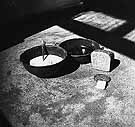
|
|
|

|

|

|

|
|
Click on an image to see a larger, more detailed picture.
|
|
|
|
|
| 1941: Mass Murder |

|
pg. 215 |

|
|
|
|
| |
 Jewish corpses fill the yard of the morgue in Bucharest, Romania, following an orgy of violence carried out by the Romanian Iron Guard. The three-day killing spree claimed the lives of more than a hundred Jews and left thousands beaten and terrified. Not content to take only the lives of their victims, the murderers also stole their clothing.
Jewish corpses fill the yard of the morgue in Bucharest, Romania, following an orgy of violence carried out by the Romanian Iron Guard. The three-day killing spree claimed the lives of more than a hundred Jews and left thousands beaten and terrified. Not content to take only the lives of their victims, the murderers also stole their clothing.
Photo: United States Holocaust Memorial Museum Photo Archive / Yad Vashem
|
 Bread and soup were the staples of the starvation diet of prisoners in the concentration camps. Jewish prisoners were allowed only a few hundred calories per day. The restricted number of calories made the Jewish prisoners much more likely to be worked to death or to succumb to typhus and typhoid.
Bread and soup were the staples of the starvation diet of prisoners in the concentration camps. Jewish prisoners were allowed only a few hundred calories per day. The restricted number of calories made the Jewish prisoners much more likely to be worked to death or to succumb to typhus and typhoid.
Photo: Panstwowe Muzeum Oswiecim
|
|
Nazi Euphemisms Nazi euphemisms played an important role in the dehumanizing process of the Holocaust. From the beginning Hitler spoke of the need to "purify" and "cleanse," to rid the Reich of the Jewish "vermin," and to "decontaminate" or "disinfect" the Reich of the Jewish "bacillus." Ultimately, the "Jewish problem" was solved through the "Final Solution" (Endlösung), a euphemism for extermination. Terms such as "euthanasia" and "mercy death" cloaked the murders of the handicapped (who were designated "unworthy of life"), which were committed for racial reasons--not to ease suffering. "Special treatment" (Sonderbehandlung) in euthanasia installations meant killing by gas. Euphemisms were used in the death camps and in reference to the massacres conducted by Einsatzkommandos. Instead of "kill" or "murder," terms such as "special action," "evacuation," and "resettlement" obscured the real intent. "Protective custody" (Schutzhaft) of opponents did not mean protection from danger but rather unlimited incarceration without trial. "Jewish residence district" (Jüdischer Wohnbezirk) was substituted for "ghetto." The "East" and "Jewish settlement region" (Jüdisches Siedlungsgebiet) became collective euphemisms for the killing centers of Poland, with the death camps referred to only as "labor," "preferential," or "POW" camps. Cruel deception and irony also marked the infamous camp-entrance signs: "Work Will Set You Free" (Arbeit Macht Frei). Within the camps, the gas chambers and crematoria received the harmless-sounding names "bath houses" (Badeanstalten) and "special installations" (Spezialeinrichtungen). Seldom has language been so cynically misused.
|
|

|

|

|

|
 January 9, 1941: Nazi police break into a house in the Warsaw Ghetto, force the women inside to undress, and prod their breasts and genitals with pistols.
January 9, 1941: Nazi police break into a house in the Warsaw Ghetto, force the women inside to undress, and prod their breasts and genitals with pistols.
|
 January 10, 1941: Dutch Jews register with German authorities.
January 10, 1941: Dutch Jews register with German authorities.
|
 January 21-24, 1941: In Romania, Iron Guard Legionnaires launch a coup d'état, during which anti-Jewish violence boils over. Thousands of Jews are beaten and over 120 killed.
January 21-24, 1941: In Romania, Iron Guard Legionnaires launch a coup d'état, during which anti-Jewish violence boils over. Thousands of Jews are beaten and over 120 killed.
|
 January 22, 1941: The Law for the Defense of the Nation is imposed by Bulgaria, forcing Jews to give up public posts and forcing Jewish doctors, lawyers, and other professionals to forfeit their jobs. Also, a selective tax is imposed on Bulgaria's Jewish shops and homes.
January 22, 1941: The Law for the Defense of the Nation is imposed by Bulgaria, forcing Jews to give up public posts and forcing Jewish doctors, lawyers, and other professionals to forfeit their jobs. Also, a selective tax is imposed on Bulgaria's Jewish shops and homes.
|
 January 29, 1941: In the Lódz (Poland) Ghetto, Bluma Lichtensztajn leaps to her death from a fourth-floor window. Prize-winning Lódz painter Maurycy Trebacz dies of starvation.
January 29, 1941: In the Lódz (Poland) Ghetto, Bluma Lichtensztajn leaps to her death from a fourth-floor window. Prize-winning Lódz painter Maurycy Trebacz dies of starvation.
|
|
|
|
|
| 1941: Mass Murder |

|
pg. 215 |

|
|
The Holocaust Chronicle
© 2009 Publications International, Ltd.
|
|
